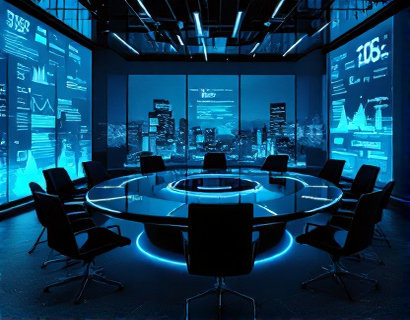Custom Business Card Creation for E-commerce Brands: A Guide to Professional Branding and Online Success
In the digital age, where online presence is crucial for business success, the importance of professional branding extends beyond the virtual realm to physical touchpoints. One such tangible element that can significantly enhance a brand's image and networking effectiveness is the custom business card. For e-commerce brands, freelancers, entrepreneurs, and corporate leaders, a well-designed business card serves as a microcosm of their brand identity, making a lasting impression in face-to-face interactions. This guide delves into the art and science of creating custom business cards that not only reflect your brand's unique identity but also contribute to your overall online and offline success.
Understanding the Role of Business Cards in Branding
The business card is more than just a piece of paper with contact information. It is an extension of your brand, a physical representation of your professional image. For e-commerce brands, which often lack a physical storefront, business cards become even more critical as they provide a tangible connection to the brand. A well-designed card can spark curiosity, build trust, and leave a memorable impression, all of which are vital for converting initial encounters into long-term business relationships.
Moreover, in a sea of digital interactions, a unique and high-quality business card can differentiate you from competitors. It serves as a conversation starter, encouraging recipients to learn more about your brand. This is particularly important for e-commerce businesses where personal connections can lead to repeat purchases and customer loyalty.
Key Elements of a Professional Business Card
To create a business card that effectively represents your brand, several key elements must be considered. These elements work together to ensure that your card is not only visually appealing but also functional and memorable.
1. Brand Colors and Logo
The use of your brand's primary colors and logo is essential. These visual elements instantly communicate who you are and help reinforce brand recognition. Consistency in color schemes and logo placement across all branding materials, including business cards, is crucial for building a strong and cohesive brand identity.
2. Typography
Font choice and size play a significant role in the readability and aesthetic of your business card. Select fonts that align with your brand's personality—whether it's modern and sleek, classic and elegant, or playful and creative. Ensure that the text is legible, with a clear hierarchy that prioritizes the most important information.
3. Contact Information
While it may seem basic, the inclusion of accurate and complete contact information is non-negotiable. This includes your name, job title, phone number, email address, and website URL. For e-commerce brands, adding social media handles can also be beneficial, providing multiple ways for potential customers to connect.
4. Unique Features
To stand out, consider incorporating unique features that add value and memorability. This could be a special finish, such as matte, glossy, or textured paper, or innovative shapes and sizes. For instance, a rounded corner or a die-cut design can make your card more noticeable and engaging.
5. Messaging and Tagline
A well-crafted tagline or a brief message can encapsulate your brand's value proposition. This should be concise yet impactful, providing a quick snapshot of what your brand offers. Ensure that the messaging aligns with your overall brand strategy and resonates with your target audience.
Choosing the Right Design for Your Business Card
With the numerous design options available, selecting the right one for your business card requires careful consideration. Here are some steps to guide you through the process:
1. Define Your Brand Identity
Before diving into design, clearly define your brand's identity. Consider your brand's personality, values, and target audience. This will help you make informed decisions about colors, fonts, and messaging.
2. Research and Inspiration
Explore design inspiration from various sources, including design blogs, social media, and business card galleries. Pay attention to what resonates with you and what doesn't. Collect examples that align with your brand's aesthetic and values.
3. Customizable Templates
Utilize customizable templates from reputable design platforms. These templates offer a solid foundation while allowing you to personalize key elements. Look for platforms that provide a wide range of templates tailored to different industries and brand styles. This approach saves time and ensures a professional look without requiring extensive design expertise.
4. Professional Design Services
If you prefer a more personalized and high-end approach, consider working with a professional designer. This option is particularly beneficial for brands with unique requirements or those looking for a bespoke design. Professional designers can bring creativity and expertise to the table, ensuring your business card stands out.
The Design Process
Once you have selected a template or hired a designer, the design process can begin. Here’s a step-by-step guide to help you navigate this phase:
1. Initial Consultation
If working with a designer, start with an initial consultation to discuss your vision, goals, and budget. This is an opportunity to provide insights and receive feedback, ensuring the final product aligns with your expectations.
2. Design Iterations
The design process typically involves multiple iterations. Provide feedback on each draft, refining the design until it perfectly captures your brand's essence. Pay attention to details such as layout, color balance, and typography.
3. Proofreading and Finalization
Before finalizing the design, conduct a thorough proofread to check for any errors in text or design elements. Ensure that all contact information is accurate and that the card meets your quality standards. Once satisfied, proceed to the printing stage.
Printing and Production
The quality of your business cards is heavily dependent on the printing and production process. Here are some factors to consider:
1. Printing Methods
Choose a printing method that best suits your design and budget. Common methods include offset printing, digital printing, and foil stamping. Offset printing is ideal for large orders and provides high-quality results, while digital printing is more cost-effective for smaller runs and allows for quick turnaround times.
2. Paper Quality
The choice of paper significantly impacts the feel and durability of your business cards. Opt for high-quality cardstock with a suitable weight (usually 250gsm or higher) to ensure a premium feel. Consider finishes like matte, glossy, or textured to add a unique touch and enhance the card's visual appeal.
3. Production Timeline
Plan ahead and allow sufficient time for the production process. Factor in lead times for design, proofing, and printing. Rush orders may compromise quality, so prioritize timely but not rushed production to ensure the best results.
Strategic Distribution and Usage
Once your business cards are ready, strategically distributing them can maximize their impact. Here are some tips for effective distribution and usage:
1. Networking Events
Networking events, industry conferences, and trade shows are prime opportunities to distribute your business cards. Carry a sufficient number and be proactive in exchanging cards with potential clients, partners, and collaborators. Personalize your approach by adding a handwritten note or a relevant comment to make the exchange more meaningful.
2. Online Presence
While business cards are physical, their impact can be amplified through your online presence. Share images of your business cards on social media platforms, incorporating them into your digital marketing materials. This not only showcases your brand's attention to detail but also provides a consistent visual experience across all touchpoints.
3. Follow-Up
After receiving a business card, send a follow-up email or message to express gratitude and keep the conversation going. This simple gesture can help maintain the connection and move it towards a more substantial business opportunity.
Conclusion
In conclusion, custom business cards are a powerful tool for e-commerce brands, freelancers, and corporate leaders to enhance their professional image and drive online success. By understanding the role of business cards, selecting the right design elements, choosing the appropriate design method, and strategically distributing your cards, you can create a lasting and positive impression. Investing time and effort into crafting a premium business card is an investment in your brand's reputation and future growth.











































